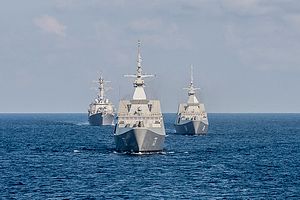The Rebalance author Mercy Kuo regularly engages subject matter experts, policy practitioners, and strategic thinkers across the globe for their diverse insights into the U.S. rebalance to Asia. This conversation with Daniel Wagner – Managing Director of Risk Solutions at Risk Cooperative and author of Global Risk Agility and Decision Making, Managing Country Risk and Political Risk Insurance Guide – is the 76th in “The Rebalance Insight Series.”
What do you see as the top five key political risks in Asia for 2017?
1. China oversteps its bounds while flexing its muscles, sparking widespread condemnation in Asia and beyond, and heightening tension throughout the region.
2. The U.S. overcompensates for missing the mark in implementing its Asia Pivot and ramps up its military presence in the South China Sea, which would also heighten regional tension.
3. North Korea successfully launches long-range ICBMs [inter-continental ballistic missiles], prompting a stern response from the U.S., leading either to a threat of war or another effort at multilateral talks.
4. Indonesia fails to successfully manage its Muslim extremist groups and regional terrorism rises.
5. Myanmar’s “experiment” with democracy proves to be a failure and the military takes over control of the government.
Explain the strategic context and catalysts of emerging market risk.
As the world continues to gyrate from the political paradigm shift under way with the rise of “alternative” political movements, emerging markets will struggle to adjust to the “new normal.” Will they become part of the shift or attempt to maintain the status quo? All countries will face this dilemma, but for developing nations and emerging markets, the stakes are even higher as, in many cases, their ability to continue to grow economically and maintain social order will depend on the continuation of a delicate balance between the rights of individuals, protection of domestic industries, minimizing income disparity, and maintaining security. Doing so becomes more difficult when the status quo elsewhere is in the process of being disrupted. Those governments that fail to anticipate the pace and depth of change may in the end fall.
Which countries hold the keys to a heightened risk environment in Asia?
Several pivotal countries hold the key to how political change manifests itself in the region in 2017 and beyond. Apart from the obvious influence of China, India, and Indonesia, some of the smaller and hitherto less influential nations may hold the key to just how dynamic political change in the region becomes. The Philippines has already proven that it can punch well above its weight by dramatically altering its political, security, and military status quo. Its embrace of China has already succeeded in upending decades of bilateral and multilateral norms. Another country that has the potential to alter the landscape is Malaysia, which has also extended its hand to China. Under Prime Minister Najib Razak, the government’s simultaneous embrace of the country’s Pan-Malaysian Islamic Party raises question about whether the country may ultimately adopt some elements of Islamic law. There is also the lingering question of whether other countries that have had an orientation toward the U.S. may change that, as the Philippines has done, and shift toward China.
What are some other risks that may impact the landscape for businesses in Asia?
The continuing rise of economic nationalism is perhaps the biggest threat to cross-border trade, investment, and lending in Asia. Since so many Asian nations depend on international trade to maintain economic growth, a deterioration in the global trade regime will have a potentially severe impact throughout the region. A gradual rise in oil prices will place economic pressure on consuming nations. The continuing slow decline in China’s economic growth will surely be felt around the region. Finally, we can expect the erosion of multilateralism more generally, as the U.S. may attempt to withdraw its membership from some of the world’s most important trade and investment agreements. Should that occur, a variety of Asian countries will undoubtedly wish to do the same thing, leading to a vicious circle of de-multilateralization.
Does the U.S. stand the risk of becoming less relevant in Asia over time?
Depending on how the U.S. addresses the ongoing disruption of the status quo in Asia in the coming four years, it will either yield to China’s rise or exist in tandem with it, but I do not believe the U.S. can supplant China’s rise, even as Beijing’s growth rates continue to decline in the longer term. The limited success of America’s Asia Pivot demonstrates the challenge any power has in projecting its power long distances in the 21st century. The same will be true of China, as it develops its blue water navy.
That said, the U.S. is not in danger of becoming irrelevant; it has too much history and too many significant allies in the region. It is, however, in danger of becoming less relevant over time. As China, India and Indonesia continue their rise, and as Asia’s tiger economies continue to grow and mature, America’s political, economic, and security role in the region will become less significant, and less meaningful.

































